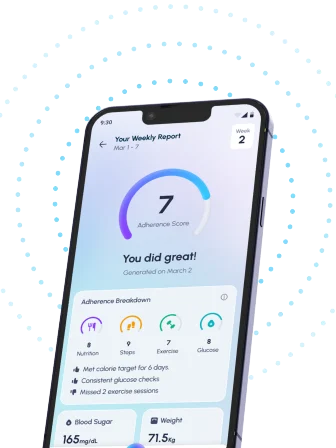Table of Contents
- Diabetes Nerve Damage: Understanding the Link
- Pinched Nerves and Diabetes: A Comprehensive Guide
- How Does Diabetes Affect Your Peripheral Nerves?
- Diabetic Neuropathy: Symptoms, Diagnosis, and Treatment
- Is Numbness a Sign of Diabetic Nerve Compression?
- Frequently Asked Questions
- References
Living with diabetes can present a multitude of challenges, and sometimes, seemingly unrelated symptoms can leave you feeling confused and frustrated. Have you experienced persistent numbness, tingling, or pain that you can’t quite explain? This could be more than just a random ache; it might be linked to a common complication: Diabetes and Pinched Nerves. In this blog post, we’ll explore the often-overlooked connection between diabetes and nerve damage, examining how high blood sugar levels can affect your nerves and what you can do to manage both conditions effectively. Let’s delve into understanding this important relationship and find ways to improve your overall well-being.
Diabetes Nerve Damage: Understanding the Link
Diabetes, a prevalent health concern particularly in India and other tropical countries, significantly impacts nerve function. A staggering 30-50% of diabetic patients experience diabetic neuropathy, a debilitating condition characterized by nerve damage. This nerve damage, often manifesting as pain, numbness, tingling, or weakness, can severely impact quality of life. Understanding this connection between diabetes and pinched nerves, or more accurately, diabetic neuropathy, is crucial for effective management.
Types and Symptoms of Diabetic Neuropathy
Diabetic neuropathy isn’t a single condition; it encompasses various types affecting different parts of the body. Peripheral neuropathy, the most common type, often affects the hands and feet, causing burning sensations, loss of feeling, and even foot ulcers. In India, where many individuals engage in manual labor, this can lead to significant work limitations and economic hardship. Autonomic neuropathy, affecting involuntary functions like digestion and heart rate, can also be a serious complication. Recognizing these symptoms early is paramount.
Managing Diabetic Neuropathy in Tropical Climates
The high temperatures and humidity prevalent in many tropical regions, including parts of India, can exacerbate the symptoms of diabetic neuropathy. Proper foot care is vital to prevent infections and complications, particularly given the increased risk of foot ulcers. Maintaining blood sugar levels within the recommended range is crucial in slowing the progression of nerve damage. Regular checkups with a healthcare professional are essential for early detection and management of this condition. Seeking timely medical attention is vital in preventing long-term complications.
Seeking Help and Support
If you or someone you know is experiencing symptoms consistent with diabetic neuropathy, consult a doctor immediately. Early diagnosis and management are key to mitigating the impact of this condition. Remember, effective diabetes management is crucial in preventing or delaying the onset of nerve damage. Support groups and healthcare professionals can provide valuable guidance and resources to navigate the challenges associated with diabetic neuropathy in your specific region. It’s also important to understand that neuropathy can occur without diabetes, so a proper diagnosis is crucial. Furthermore, experiencing cramps can sometimes be linked to diabetes, highlighting the importance of comprehensive medical attention.
Pinched Nerves and Diabetes: A Comprehensive Guide
Diabetes significantly increases the risk of nerve damage, a condition known as diabetic neuropathy. This complication affects millions globally, and its prevalence is particularly noteworthy in India and other tropical countries due to various lifestyle and environmental factors. A common manifestation of diabetic neuropathy is pinched nerves, often in the feet and legs, leading to debilitating pain and reduced mobility. Understanding this connection is crucial for effective management and prevention of serious complications.
Understanding the Link Between Diabetes and Pinched Nerves
High blood sugar levels characteristic of diabetes damage blood vessels, including those supplying nerves. This compromised blood flow deprives nerves of essential nutrients and oxygen, leading to inflammation, swelling, and ultimately, nerve compression or “pinching.” This process can affect peripheral nerves, manifesting as tingling, numbness, burning sensations, and even severe pain, especially in the extremities. These symptoms can be exacerbated by pre-existing conditions like foot deformities which are more common in certain populations. The impact of pinched nerves is significant, as it can lead to reduced sensation, increasing the risk of injury, infection, and ultimately, foot ulcers. This is especially concerning given that swelling in the feet is also a common diabetic complication. For more information on this connection, see our article on Does Diabetes Cause Swollen Feet? Understanding the Connection.
The High Risk of Foot Ulcers in Diabetics
The connection between diabetes, pinched nerves, and foot ulcers is particularly alarming. Nearly 15% of diabetics experience foot ulcers in their lifetime, significantly increasing the risk of amputation. Early detection and management of neuropathy are vital in preventing this devastating outcome. In tropical climates, where infections are more prevalent, the risk of complications from foot ulcers is even higher. Regular foot checks, proper footwear, and meticulous foot care are essential preventative measures.
Taking Control of Your Diabetic Neuropathy
For individuals living with diabetes in India and other tropical countries, proactive management is crucial. Regular consultations with your doctor and podiatrist, along with adherence to a prescribed treatment plan, are paramount. Maintaining healthy blood sugar levels through diet, exercise, and medication, along with meticulous foot care, can significantly reduce the risk of pinched nerves and their associated complications. As you age, managing diabetes becomes even more crucial. Check out our guide on Managing Diabetes as You Age: Challenges and Solutions for additional support and strategies. Don’t hesitate to seek immediate medical attention if you experience any signs of nerve damage in your feet or legs. Your health and well-being depend on it.
How Does Diabetes Affect Your Peripheral Nerves?
Diabetes, a prevalent health concern particularly impacting a significant portion of the 20-64 age group (61%, according to the International Diabetes Federation), can severely damage your peripheral nerves. This condition, known as diabetic neuropathy, arises from persistently high blood sugar levels. The excess glucose damages the blood vessels supplying your nerves, leading to nerve dysfunction and a range of unpleasant symptoms. This is especially crucial to understand in Indian and tropical countries where diabetes prevalence is high and access to healthcare might be limited. Understanding how diabetes affects blood flow, as discussed in our article How Does Diabetes Affect Blood Flow?, is key to comprehending the development of diabetic neuropathy.
Understanding the Symptoms
Symptoms of diabetic neuropathy vary, but common experiences include numbness, tingling, or burning sensations, often in the feet and legs. These can progress to intense pain, muscle weakness, and even digestive issues or bladder problems. The impact on daily life can be significant, affecting mobility, sleep, and overall well-being. In hot and humid tropical climates, existing nerve damage can be further exacerbated by discomfort and impaired circulation.
Seeking Help and Management
Early diagnosis and effective management are crucial for mitigating the long-term effects of diabetic neuropathy. Regular blood sugar monitoring, coupled with a healthy diet, regular exercise, and prescribed medications, are essential steps. Consulting with a healthcare professional, ideally one specializing in diabetes management, is paramount. In India and other tropical countries, access to specialized diabetic care varies; thus, proactive steps are even more critical. Remember, many effective treatments and lifestyle modifications are available to help manage diabetic neuropathy and improve your quality of life. Don’t delay seeking professional help; your health is paramount. It’s also important to be aware of how diabetes can impact other systems, such as the respiratory system, as detailed in our article How Does Diabetes Affect the Respiratory System?.
Diabetic Neuropathy: Symptoms, Diagnosis, and Treatment
Understanding Diabetic Neuropathy in Tropical Climates
Diabetic neuropathy, a common complication of diabetes, significantly impacts the quality of life for millions. High blood sugar levels damage nerves over time, leading to various symptoms depending on the type of nerve affected. In tropical and Indian countries, where diabetes prevalence is high, understanding these symptoms is crucial for early diagnosis and intervention. Early detection is key, as untreated neuropathy can lead to serious complications.
Recognizing the Symptoms
Symptoms vary widely, from tingling and numbness (often in the feet and hands – peripheral neuropathy) to sharp pains, burning sensations, and muscle weakness. Some individuals might experience digestive issues, such as constipation or diarrhea, due to nerve damage in the gastrointestinal tract. In severe cases, loss of sensation can lead to unnoticed injuries and infections, posing a significant risk, particularly in hot and humid climates common in many tropical regions. Paying attention to even minor changes in sensation is vital. For example, experiencing heel pain could be an early indicator.
Diagnosis and Treatment Approaches
Diagnosis typically involves a thorough medical history, neurological examination, and nerve conduction studies. Treatment focuses on managing blood sugar levels through diet, exercise, and medication. Pain management might involve medication, physiotherapy, and alternative therapies like acupuncture, which are prevalent in some parts of India and other tropical areas. Maintaining good blood sugar control is the most effective way to prevent further nerve damage. This is particularly important given the increased risk of complications like kidney disease; nearly 30% of people with diabetes develop diabetic nephropathy. While managing blood sugar is crucial, some explore alternative options; learn more about the potential benefits of THC for diabetic neuropathy.
Seeking Timely Medical Attention
In conclusion, for individuals in India and tropical countries living with diabetes, understanding diabetic neuropathy and its varied symptoms is paramount. Regular checkups with your doctor, including foot examinations and blood sugar monitoring, are essential for early detection and management. Don’t hesitate to seek medical attention if you experience any unusual sensations or pain in your limbs. Early intervention significantly improves the chances of managing neuropathy effectively and avoiding serious complications.
Is Numbness a Sign of Diabetic Nerve Compression?
Numbness, tingling, or burning sensations in the hands and feet are common symptoms of peripheral neuropathy, a nerve damage complication frequently associated with diabetes. This nerve damage can manifest as diabetic nerve compression, also known as diabetic neuropathy, significantly impacting the quality of life, particularly in hot and humid climates prevalent in many Indian and tropical countries. The increased risk of sleep apnea (70% higher in diabetics) further exacerbates this issue, leading to poor sleep quality and potentially worsening nerve function. This is further complicated by the fact that feeling sleepy after eating can sometimes be a sign of diabetes, as discussed in our article, is feeling sleepy after eating a sign of diabetes.
Understanding the Connection
High blood sugar levels over extended periods damage blood vessels, including those supplying nerves. This reduced blood flow deprives nerves of essential nutrients and oxygen, leading to nerve damage and potentially compression. Symptoms can range from mild numbness to severe pain, impacting daily activities like walking, gripping objects, and even simple tasks like buttoning clothes. Early detection and management are vital. It’s important to remember that while numbness is a key indicator, it’s not the only sign. Other symptoms can include weakness, muscle cramps, and digestive issues. For more information on numbness, particularly in the feet, you might find our article on Numbness in Feet: Symptoms, Causes and Treatment helpful.
Seeking Help in Tropical Climates
In Indian and tropical countries, where high temperatures and humidity can further aggravate nerve pain, it is crucial to consult a doctor immediately if you experience any of these symptoms. Early diagnosis and treatment, including lifestyle modifications and medication, can help manage diabetic nerve compression and significantly improve your overall well-being. Don’t hesitate to seek medical attention; proactive care is essential in preventing further complications and improving your quality of life. Regular check-ups and proactive management of blood sugar levels are key strategies in mitigating the risk of diabetic neuropathy.
Frequently Asked Questions
Q1. What is diabetic neuropathy?
Diabetic neuropathy is nerve damage caused by high blood sugar levels. It’s a common complication of diabetes, affecting 30-50% of people with the condition, especially those in tropical climates.
Q2. What are the common symptoms of diabetic neuropathy?
Common symptoms include pain, numbness, tingling, and weakness, most often in the hands and feet (peripheral neuropathy). It can also affect involuntary functions like digestion (autonomic neuropathy).
Q3. How can I manage diabetic neuropathy?
Managing diabetic neuropathy focuses on strict blood sugar control through diet, exercise, and medication. Meticulous foot care and regular checkups with your doctor are also crucial.
Q4. Why is early diagnosis and treatment important for diabetic neuropathy?
Early diagnosis is vital to prevent serious complications such as foot ulcers and amputation, which can result from reduced sensation and impaired circulation in the feet. Prompt treatment helps mitigate long-term effects and improve quality of life.
Q5. What are some less common but important symptoms of diabetic neuropathy to watch for?
Besides numbness, tingling, and pain, watch for weakness, cramps, and digestive problems. These can all be indicators of diabetic neuropathy.
References
- A Practical Guide to Integrated Type 2 Diabetes Care: https://www.hse.ie/eng/services/list/2/primarycare/east-coast-diabetes-service/management-of-type-2-diabetes/diabetes-and-pregnancy/icgp-guide-to-integrated-type-2.pdf
- What is Diabetes: https://www.medschool.lsuhsc.edu/genetics/docs/DIABETES.pdf




